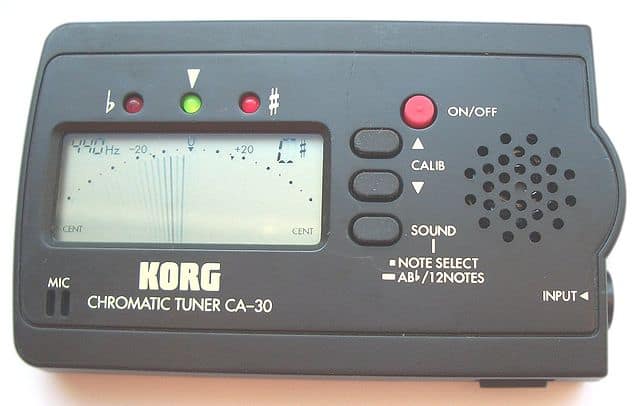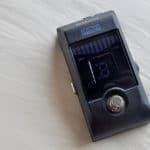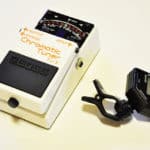Playing guitar is a joyful experience.
Unfortunately, it requires certain considerations.
To be more precise, we are trying to say that, if you’re playing guitar, then you’ll need to play it right.
Playing guitar “right” is not a matter of playing better than certain guitarists, or sticking to one style or another.
Playing right means playing in tune.
Indeed, a guitar out of tune is a recipe to bleed your ears. If you want to play guitar, then you MUST learn how to tune it.
Luckily, you don’t have to tune by ear. This ability is acquired over the years, and even the most professional guitarists in this world need to use tuners to do it assertively.
So, the solution is either to buy a guitar tuner or download a free one with your smartphone.
You’re probably thinking about jumping right into the free option, right? The tuning app.
Tuning apps are good, there’s no doubt about it. But are they better than a real guitar tuner?
Although an app tuner is not as accurate as a physical tuner, it’s a convenient tool that can save your day. Other than that, a pedal tuner or clip-on tuner will always be a better choice. If you have some extra bucks, then invest in one because it is worth the price.
There’s more to choose from than only two or three options. In fact, alternatives are plenty.
Let’s see the different types of tuners, and which one suits your interests better.
Different types of standalone guitar tuners
Let’s leave tuning apps for a while, just to focus on regular, physical guitar tuners.
There are different options to choose from, so let’s make a quick summary of them all.
Strobe
It’s said to be the most accurate tuner in the entire market.
As it turns out, they are more expensive in comparison with the rest of the tuners on this list. However, its effectiveness is, for many, worth the price.
The tuner displays a differentiation between a reference frequency and a musical note. To be more precise, they are stroboscopes that flicker a light with the same frequency as the note.
This tuner is a top-notch choice for producers and guitar technicians.
Chromatic
A rather common tuner, and the most usual in this list.
With a chromatic tuner, you can tune to all 12 notes within the chromatic scale.
This is great for tackling the note you are looking to achieve immediately. So, for example, if you want to tune to drop D, you may simply tune down (or tune from low to high) until the tuner detects the D note.
Bear in mind, that beginner guitarists could find it a bit hard to grasp unless they know which notes they are looking for.
Polyphonic
With a Polyphonic tuner, you may be able to play all of your strings at once, then check for the ones that are out of tune.
Naturally, one will need to tune each string in isolation. However, it’s a quick solution for guitarists who are in the heat of performance and need to check which notes need to be tuned.
Microphone
As the name implies, this tuner has an in-built microphone to grasp the frequencies by air.
These are the ones that come in metronomes, for example.
Of all the tuners on this list, we could argue that this one is the least accurate of them all. Nonetheless, we’re not implying that they’re not effective whatsoever.
The truth is that they will definitely work and help you tune your strings the right way.
The only issue is that considering that the in-built microphone picks up air frequencies, it will not only detect the notes you’re playing but also any other sound coming from the room.
That means that microphonic tuners are not a good option for live performances. But they will work for rehearsals when you’re alone in your room.
Other types
- Clip-On Tuner: These are those devices you place on the top of the headstock to perceive the vibration of the string and detect the note.
- Pedal tuners: as the name implies, they are a pedal that allows tuning the instrument. Rather convenient!
- Handheld: common tuner that works either with a jack connection for electrics, or a microphone for acoustics.
- Sound Hole: it’s designed for acoustic guitars. The tuner is mounted on the guitar, which makes it a rather comfortable choice.
- Rack Tuners: for guitarists who use rack gear.
Benefits of using an app tuner
Whenever you take out your smartphone to open the tuning app and tune your guitar, there’s a chance of having a purist saying “Ohhhh, buy yourself a tuner, for God’s sake!”
Is he right? Or is he just an old guy complaining about how better things used to be in the past?
Well, he might be a bit wrong, because using an app tuner has many benefits.
First of all, it’s useful. Some people may doubt the accuracy of an app for this kind of job.
In reality, an app tuner will work just like (almost) any microphonic tuner. As long as the app has been well programmed and developed, then you can expect to tune your string appropriately.
Second, an app tuner is comfortable. After all, you don’t need to take up more space in your bags or pockets.
You will probably be carrying your phone wherever you go anyways, so there’s no need to fill in more space with yet another tuner.
Sure, tuners are generally small and take up little to no space at all, but a fact is a fact, and having a tuning app installed on your phone makes it easier to gain access to it.
Now that we mentioned it, there we have another advantage of a tuning app: its accessibility.
For example, one thing is to go to a rehearsal room with your band or to a jam session at your best friend’s house. In that case, you will probably take with you a guitar tuner because, of course, you know you’ll play guitar.
But what happens if you go camping, to a party, or to a simple meeting at the beach? What if someone takes a guitar with them and asks you to play some songs?
Oh, but your ear is not that sharp, and you’re still not able to tune an instrument without a tuner. What are you gonna do?!
Oh, right. You already have a tuner in your phone, problem solved.
Lastly, downloading an app to your phone is free, at least in most cases. Thus, you won’t have to spend extra money on a tuner.
Simply find the one that you believe will be the best and go tune your strings!
Limitations using your phone to tune your guitar
Now, that annoying guy who made fun of you for using an app tuner may be slightly right in some way.
After all, tuning your guitar with a phone has certain disadvantages that need to be taken into consideration.
For example, tuning apps are microphonic tuners. This means that they will be ineffective for areas with lots of noise.
They will pick up unwanted frequencies that could interfere with and affect results.
What’s more, the built-in microphone of a cellphone is not as good as the one on a tuner.
Remember that a tuner is created to serve a sole purpose: to tune the strings of a guitar accurately.
On the contrary, the smartphone microphone is built to work as… well… a microphone. This will inevitably make it a less reliable option in comparison with standard tuners.
But let’s not forget, under the right conditions (non-noise-polluted areas, guitar sound loud enough) the app tuner will work impeccably.
Tuner app vs clip-on tuner
As we have already discussed, clip-on tuners pick up the vibrating frequencies from the machine head.
As a result, we can conclude that a clip-on tuner is more effective than a tuner app. After all, the direct resonant frequency is more accurate than the estimation of the tuning app.
Not to mention, a clip-on tuner won’t have problems in noisy environments.
In other words, you’ll be able to tune despite unwanted noises, including during live performances or rehearsals.
Contrarily, a tuner app will find it impossible to pick up the right sound coming from the guitar if there are other agents that interfere with the process.
Therefore, it is safe to mention that the clip-on tuner wins over any app.
Why professionals use pedal tuners
It’s common to find professional guitarists tuning with a pedal tuner, instead of an app, or a clip-on tuner.
The reasons are plenty, and rather logical.
All in all, pedal tuners are comfortable. They are at the reach of their hands (or their feet haha terrible joke, I’m sorry), so they simply press a pedal and can tune their strings immediately.
In addition, pedal tuners’ results are always accurate, even if the room is lousy.
Consider that professional guitarists tend to play in front of audiences who, one way or another, will produce too much noise. And let’s not talk about the racket produced by the other members of the band.
Luckily, connecting a guitar to the pedal tuner helps achieve successful outcomes without needing to ask the bandmates to make some silence.
Lastly, consider how unprofessional it would be to see a guitarist taking his or her cellphone out during a performance and tuning with its app. Just horrible!
There’s room for both solutions
We would like to end this article with a final thought: you don’t have to be rigid in your decision.
What we’re trying to say is that you can always switch between options, instead of sticking to only one.
After all, tuning apps are good tools for musicians. They are a fast and comfortable solution for moist guitarists who struggle to tune by ear.
Plus, who knows? Maybe your physical tuner stops working all of a sudden, and having an app on your phone could save your day.
Take the tuning app just as a plan B or to noodle around.
Now, if you want to be a professional, or simply to play on gigs or practice sessions, then use a pedal tuner.

Hello there, my name is Ramiro and I’ve been playing guitar for almost 20 years. I’m obsessed with everything gear-related and I thought it might be worth sharing it. From guitars, pedals, amps, and synths to studio gear and production tips, I hope you find what I post here useful, and I’ll try my best to keep it entertaining also.





